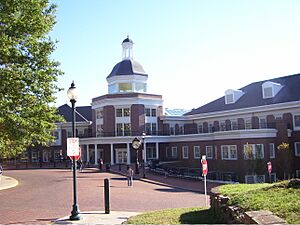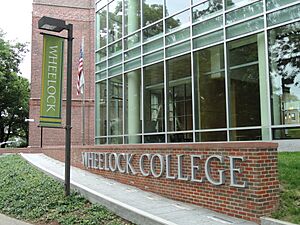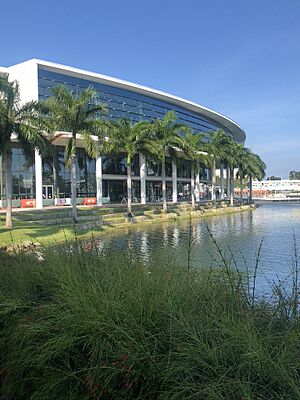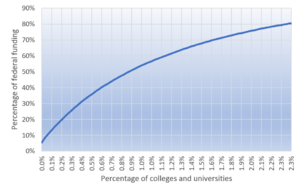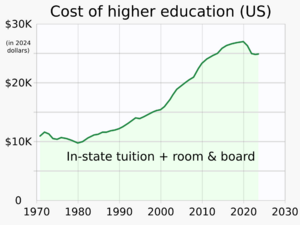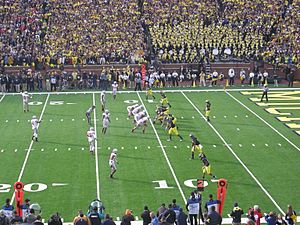Higher education in the United States facts for kids
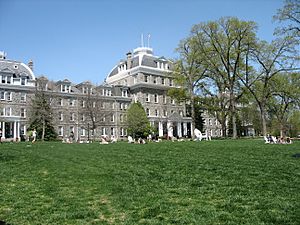
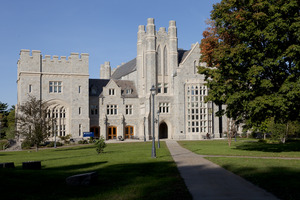
In the United States, higher education is the level of school that comes after high school. It's also called post-secondary or tertiary education. People go to schools known as colleges or universities for higher education.
There are about 3,900 of these schools in the U.S. They can be public (run by the government) or private. Some are large research universities, while others are smaller liberal arts colleges or community colleges.
Going to college became much more common after World War II. Many people saw it as a key part of achieving the American Dream. However, some people today question if the high cost of college is worth it. There is also criticism that the most famous schools, like those in the Ivy League, get more attention than others.
In 2022, about 16 million students were in college. More women (9.6 million) were enrolled than men (6.6 million). The number of students going to college was highest in 2010 and has been slowly going down since then.
American universities are known for their strong research programs, which attract students and professors from all over the world. They are also famous for competitive college sports, especially American football and basketball.
Contents
- History of U.S. Colleges
- What is the Purpose of College?
- Types of Colleges and Universities
- How Colleges and Students Pay the Bills
- College Admissions
- College Sports
- Current Issues in Higher Education
- See also
History of U.S. Colleges
From Colonial Times to the 1800s
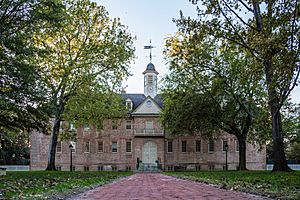
The first colleges in America were started by religious groups. Their main goal was to train ministers. These early schools, known as the colonial colleges, only allowed white men to attend. For over 150 years, these colleges also relied on the free labor of enslaved African people. Land for many colleges was also taken from Native American nations through treaties.
In the 1800s, many more small colleges opened, often started by Protestant and Catholic churches. The classes were small and focused on liberal arts. Students learned subjects like Greek, Latin, geometry, and history. They were expected to memorize information perfectly.
These small colleges helped young men move from farm life to city jobs. However, the most famous colleges, like Harvard and Princeton, mostly served wealthy families. This helped create a powerful upper class in the Northeastern United States.
Catholic Colleges
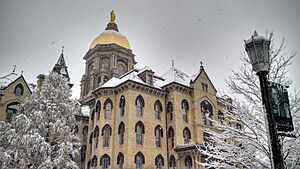
The Association of Catholic Colleges and Universities was started in 1899. It helps Catholic schools share ideas. In recent years, there have been debates about how these schools should balance their religious and academic goals.
Historically Black Colleges and Universities (HBCUs)
Most Historically Black Colleges and Universities (HBCUs) were started in the South after the American Civil War. This was often done with help from religious groups in the North. A few HBCUs, like Cheyney University of Pennsylvania (1837), existed before the Civil War. These schools gave African Americans the chance to get a higher education when most other colleges would not accept them.
Key Government Laws for Education
- Morrill Act (1862 and 1890): Helped create colleges by giving states land to sell.
- G.I. Bill (1944): Paid for college for soldiers returning from World War II.
- Higher Education Act (1965): Created grants and loans to help students pay for college.
- Education Amendments (1972): Banned gender discrimination in schools, which helped women's sports grow.
The 1900s: A Century of Growth and Change
At the start of the 20th century, there were fewer than 1,000 colleges in the U.S. Over the next 100 years, that number grew quickly. State universities expanded from small schools into huge campuses with tens of thousands of students.
A new type of school called the junior college also appeared. These schools offered two-year programs and were cheaper and closer to home for many students. By the 1960s, they were renamed "community colleges." They became popular for job training and as a starting point for students who planned to transfer to a four-year university.
During the 1960s and 1970s, college students became very involved in social movements. They organized protests for civil rights and against the Vietnam War. They also led movements for women's rights and other causes.
The 2000s: Technology and New Challenges
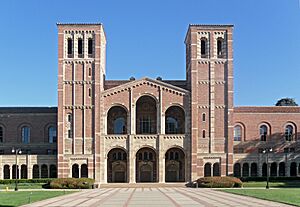
The 21st century has brought big changes to higher education, including new technology and financial problems for some schools.
Online Learning
Online education has become much more common. In 2017, about 15% of all college students took their classes only online.
One type of online learning is the MOOC, or massive open online course. These are free online classes that anyone can join. They were very popular around 2012, but researchers found that very few people actually finished them.
Another trend is the rise of coding bootcamps. These are short, intense programs that teach computer programming skills.
Financial Problems and School Closures
Hundreds of colleges are struggling with money. Some have had to close or merge with other schools. This is partly because fewer students are enrolling in college. In 2017, the credit rating agency Moody's gave U.S. higher education a "negative" outlook, meaning it expected financial problems to continue.
Are Students Ready for College?
Many reports show that a large number of high school students are not fully prepared for college-level work. For example, a 2023 report from ACT, a company that makes a college entrance exam, said that only about one in five high school graduates was ready for core college classes.
What is the Purpose of College?

Higher education in the U.S. is mainly a place for learning and creating knowledge. But it also has other purposes. It gives people the credentials they need for professional jobs, like becoming a doctor or lawyer. For many, it is a way to achieve a better life and a higher social status.
Going away to a four-year college is also seen as a rite of passage. It is an experience that helps young people become independent adults.
American universities are often ranked among the best in the world. This is partly because they receive a lot of money for research. However, public opinion about colleges has been going down. Many people, especially Republicans, feel that higher education is heading in the wrong direction and costs too much.
Types of Colleges and Universities
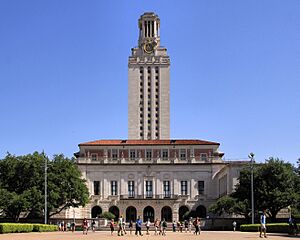
There are many different kinds of colleges. Some focus on job training, like in engineering or business. Others focus on a liberal arts education, which includes subjects like history, literature, and science. Many large universities offer all of these.
What's the Difference Between a "College" and a "University"?
The word "college" can mean a few different things:
- A school that offers a four-year bachelor's degree but is not part of a larger university.
- A community college that offers a two-year degree.
- A specific school within a big university (like the "College of Engineering" at a university).
A university is usually a larger institution that has both undergraduate programs (for bachelor's degrees) and graduate programs (for master's degrees and doctorates, or Ph.D.s). Universities are often made up of different "colleges" or "schools," such as a business school or a medical school.
Most universities in the U.S. are not controlled by the national government. Public universities are run by each state. Private universities are run independently. Some are secular (not religious), while others have religious connections.
Liberal Arts Colleges
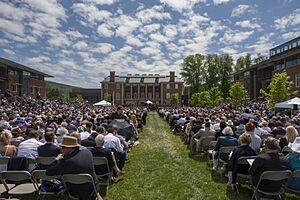
Liberal arts colleges are usually small, four-year schools. They focus on teaching small, interactive classes. Most are private and students often live on campus. They offer a broad education in subjects like history, languages, math, and science.
Community Colleges
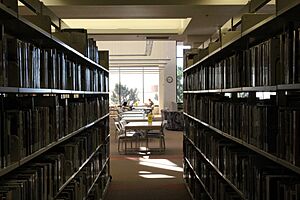
Community colleges offer two-year programs. They have open admissions, which means almost anyone with a high school diploma can attend. Tuition is usually much lower than at four-year schools. Students can earn an associate degree and then either get a job or transfer to a four-year university to complete a bachelor's degree.
How Colleges and Students Pay the Bills
Where Colleges Get Their Money
Public colleges get a large part of their funding from state governments. Private colleges rely more on tuition and donations. Many universities also have an endowment, which is a large fund of money that has been donated over many years. The university invests this money and uses the earnings to pay for its costs. Some universities have endowments worth billions of dollars.
How Students Pay for College
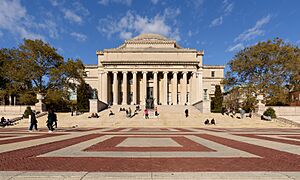
The cost of college has been rising for decades. In 2016, the average yearly cost for a student at a public college was about $16,757. At a private college, it was about $43,065.
To help pay these costs, students can get financial aid. This can come in several forms:
- Grants and Scholarships: This is money that does not have to be paid back. Some are "need-based" (for students from low-income families) and some are "merit-based" (for students with high grades or special talents).
- Student Loans: This is money that is borrowed and must be paid back with interest. In 2021, total student loan debt in the U.S. was over $1.7 trillion.
- Work-Study Programs: These programs provide students with part-time jobs on campus to help them earn money for school.
To apply for federal financial aid, students must fill out a form called the Free Application for Federal Student Aid, or FAFSA.
College Admissions
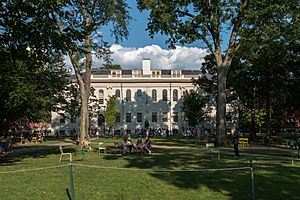
Getting into college can be competitive, especially at famous schools. When students apply, colleges look at several things:
- High school grades (GPA)
- Scores on standardized tests like the SAT or ACT
- The college application essay
- Letters of recommendation from teachers
Some schools also give special preference to "legacies," who are students whose parents or other family members went to that same school.
College Sports
College sports are a huge part of American university life. The main governing body for college sports is the National Collegiate Athletic Association (NCAA). The NCAA has three main divisions.
- Division I schools are usually the largest and have the most competitive teams. They can offer students athletic scholarships to play sports.
- Division II schools can also offer athletic scholarships, but are generally smaller.
- Division III schools cannot offer athletic scholarships.
Big-time college sports, like football and basketball, are very popular and make billions of dollars from ticket sales and TV contracts. In many states, the highest-paid public employee is the head football or basketball coach of the state university.
Current Issues in Higher Education
Higher education in the U.S. faces many challenges today. These include rising costs, student debt, and questions about the value of a degree.
Enrollment has been declining since 2011. This is partly because of lower birth rates and a stronger economy, which gives young people more job options without a degree. Some experts predict that many more small colleges may have to close in the coming years.
There have also been problems with prejudice on campuses. Reports of unfair treatment against Jewish students have increased, causing some universities to be investigated by the government.
Another issue is money from other countries. Some foreign governments have donated billions of dollars to U.S. universities. This has raised concerns that these countries might be trying to influence what is taught or researched at the schools.
See also
- Association of American Universities
- Lists of American universities and colleges


